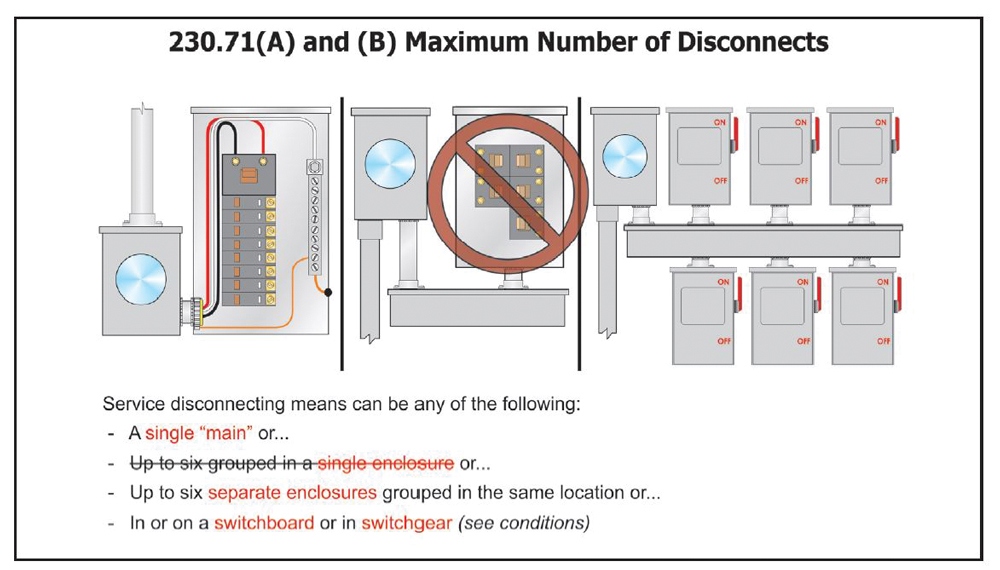230.71 Maximum Number of Disconnects in Single Enclosure
Change Summary
- Revision eliminates more than one service disconnecting means in the same panelboard or other enclosure. Continues to retain the six service disconnect rule for services; however, the permission for up to six service disconnects is modified to require installation in separate enclosures only.
So the service disconnecting means for each service is still permitted to consist of not more than six switches or sets of circuit breakers, or a combination of not more than six switches and sets of circuit breakers, located in a group of separate enclosures, or in or on a switchboard or in switchgear. These up to six means of disconnect can no longer be mounted in a single enclosure.
| NEC® Text |
|---|
|
230.71 Maximum Number of Disconnects. Material taken from the National Electric Code® is reprinted with permission from NFPA 70®, 2020 edition. |
Expert Analysis
All services are required to provide a means for disconnecting for all conductors installed in a building or other structure from the service-entrance conductors. Service disconnecting means must be installed in a readily accessible location and can be located outside the building or inside the building; but if located inside the building, the disconnecting means has to be located “nearest the point of entrance” from where the service conductors enter the building. Generally, buildings or structures are permitted to have only one service.
Several conditions exist at 230.2 that would allow the AHJ to permit more than one service per building or structure. A service disconnecting means is required for each service permitted by the Code. No more than six service disconnects per service may be grouped in any one location per the requirements of 230.71(A).

Historically the service disconnecting means could be either a single disconnect or it is permitted to consist of not more than six switches or six circuit breakers mounted in a single enclosure, in a group of separate enclosures, or in or on a switchboard. This requirement allowing six means of disconnect in a single enclosure or in up to six separate enclosures has been a part of the Code since the 1937 edition of the NEC. This will no longer be true for the 2020 NEC. The service disconnect can still consist of up to six means of disconnect, but these multiple disconnects will now be required to be located in separate enclosures, they cannot be located within the same enclosure.
This revision takes into consideration the challenges created for electrical workers when encountering a panelboard with more than one service disconnecting means in the same enclosure. The six means of disconnect rule for a single enclosure makes it impossible to work in service equipment when applying electrical safe work practices in accordance with NFPA 70E (Standard for Electrical Safety in the Workplace). A single service disconnect within service equipment provides additional protection from electric shock hazards helping to facilitate the ability to create an electrically safe work condition by opening the single service disconnect where barriers are in place over the exposed energized conductors/terminals to eliminate any live exposed parts. Barriers are required to be provided to eliminate live exposed parts for switchboards, switchgear and panelboards in accordance with 408.3(A)(2).
This revision at 230.71 retains the six means of disconnect rule for services, but now requires that these up to six means of disconnect be installed in separate enclosures.







